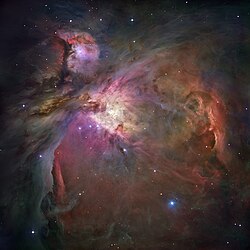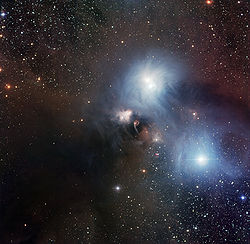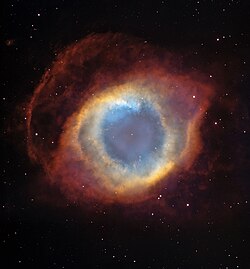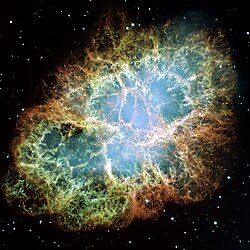Nebula
| It's not rocket science, it's... Astronomy |
| The Final Frontier |
| The abyss stares back |
A nebula ("cloud" or "fog" in Latin,[1] plural nebulae)[2] is a distinct part of the interstellar medium, having a larger concentration of gases (mostly hydrogen in either atomic or molecular form and helium) plus interstellar dust and heavier elements than helium.
Despite nebulae being both quite large, with sizes of up to hundreds of light years, and denser than the space that surrounds them, by Earth standards are extremely rarefied and equivalent to a vacuum; while air has a density at sea level of 1019 molecules per cubic centimeter, a dense nebula would just have some thousands of molecules in such volume. This also means they don't work at all as in the second movie of Star Trek, where the "Enterprise" and the "Reliant" played hide-and-seek in one, and in addition to that since their surface brightness![]() do not change they (like other extended bodies as galaxies, for that matter too) from close by they would appear just larger but not brighter (i.e., if the Great Orion Nebula
do not change they (like other extended bodies as galaxies, for that matter too) from close by they would appear just larger but not brighter (i.e., if the Great Orion Nebula![]() was ten times closer it would appear one hundred times brighter by virtue of the Inverse square law
was ten times closer it would appear one hundred times brighter by virtue of the Inverse square law![]() but its surface area would now be one hundred times larger (102=100) too so things would not change, meaning it would offer to the naked eye quite a show from a place faraway of city lights and pollution (it can be spotted without optical aid, even from sites with light pollution
but its surface area would now be one hundred times larger (102=100) too so things would not change, meaning it would offer to the naked eye quite a show from a place faraway of city lights and pollution (it can be spotted without optical aid, even from sites with light pollution![]() ), but from a city save for its brightest embedded stars would be much less impressive or even invisible).[3]
), but from a city save for its brightest embedded stars would be much less impressive or even invisible).[3]
Types[edit]
Four major types of nebulae are classified, even as our knowledge has improved with time other types have been added on. Earlier on, galaxies and star clusters![]() that could not be resolved into stars were lumped together in this classification but that's no longer the case save in very old astronomy textbooks.
that could not be resolved into stars were lumped together in this classification but that's no longer the case save in very old astronomy textbooks.
Emission nebulae[edit]
Also known as H II regions. In them, hydrogen is ionized[4] by the ultraviolet emission of young, massive, stars (spectral type O and very early B) that have formed within them, causing them to shine with a characteristic red color. Like such stars, they're short-lived in astronomical terms (just some millions of years), given that both the powerful stellar winds![]() of these stars and their death as supernovae will end up driving most of the gas away.[5] They include some of the most photogenic objects of the sky as the already mentioned Great Orion Nebula.
of these stars and their death as supernovae will end up driving most of the gas away.[5] They include some of the most photogenic objects of the sky as the already mentioned Great Orion Nebula.
Reflection nebulae[edit]
Reflection nebulae![]() shine by reflecting the light of nearby star(s), that emit insufficient ultraviolet radiation to ionize the gas, and as the former are also sites of recent star formation. Since blue light is more easily scattered than red light, they appear bluish in photos, with some exception as the red supergiant star Antares,
shine by reflecting the light of nearby star(s), that emit insufficient ultraviolet radiation to ionize the gas, and as the former are also sites of recent star formation. Since blue light is more easily scattered than red light, they appear bluish in photos, with some exception as the red supergiant star Antares,![]() that is surrounded by one of such color. Sometimes, as in the famous Trifid Nebula,
that is surrounded by one of such color. Sometimes, as in the famous Trifid Nebula,![]() they may share space with emission nebulae.
they may share space with emission nebulae.
Dark nebulae[edit]
Dark nebulae![]() are so dense and contain so much interstellar dust that they obstruct the light, at least visible light (infrared and radio waves can bypass them), of objects behind them thus appearing as dark clouds silhouetted against a bright background. For example, the band of the Milky Way as can be readily seen with the naked eye by observing from the Cygnus constellation southwards.
are so dense and contain so much interstellar dust that they obstruct the light, at least visible light (infrared and radio waves can bypass them), of objects behind them thus appearing as dark clouds silhouetted against a bright background. For example, the band of the Milky Way as can be readily seen with the naked eye by observing from the Cygnus constellation southwards.![]() The southern hemisphere also offers a view of the famous Coalsack nebula,
The southern hemisphere also offers a view of the famous Coalsack nebula,![]() close to the constellation of the Southern Cross.
Dark nebulae are also known as "molecular clouds", given that the hydrogen within them is in molecular form, with some of them being quite large
close to the constellation of the Southern Cross.
Dark nebulae are also known as "molecular clouds", given that the hydrogen within them is in molecular form, with some of them being quite large![]() in both mass and size, often forming large complexes, and most notably they are the places where stars are being born, once the density is high enough to start such process (eventually transforming into emission and/or reflection nebulae, depending of what kind of stars are being born into them).[6][7] They can also contain other molecules, detectable thanks to radio astronomy.
in both mass and size, often forming large complexes, and most notably they are the places where stars are being born, once the density is high enough to start such process (eventually transforming into emission and/or reflection nebulae, depending of what kind of stars are being born into them).[6][7] They can also contain other molecules, detectable thanks to radio astronomy.
The smallest dark nebulae are named Bok globules![]() and are cocoons of cold gas and dust surrounding stars in formation.
and are cocoons of cold gas and dust surrounding stars in formation.
Planetary nebulae[edit]
Planetary nebulae![]() are the graves of low- and intermediate-mass (0.5 - ~8 solar masses) stars, consisting of shells of gas emitted by the dying suns in their latest evolutionary stage
are the graves of low- and intermediate-mass (0.5 - ~8 solar masses) stars, consisting of shells of gas emitted by the dying suns in their latest evolutionary stage![]() , surrounding the former core of the star, now collapsed into a white dwarf, whose intense ultraviolet radiation ionizes the surrounding gases (i.e., they're very small H II regions[8]). They were given their name by the first astronomical observers who were initially unable to distinguish them from planets, and who tended to confuse the former with the latter, which were of more interest to them.
, surrounding the former core of the star, now collapsed into a white dwarf, whose intense ultraviolet radiation ionizes the surrounding gases (i.e., they're very small H II regions[8]). They were given their name by the first astronomical observers who were initially unable to distinguish them from planets, and who tended to confuse the former with the latter, which were of more interest to them.
It's thought that our Sun will produce a planetary nebula when it dies around 7.6 billion years from now.[9]
The lifetime of these objects is very short (just some dozens of thousands of years), as both the gases end up being so far away that the white dwarf cannot ionize them, and as it cools it emits less ultraviolet radiation becoming unable to excite them efficiently. A previous, still shorted-lived, phase is the Protoplanetary nebula![]() that consists of a small reflection nebulae caused when the central star is not hot enough to ionize the expelled gases (i.e., its core is not still naked and mass loss has not revealed it).[10] Also, in theory they should appear as spherical shells surrounding the white dwarf core; however and as usual nature is far more complicated than that, and companion star(s) and planets, magnetic fields, among other processes not fully understood can produce a lot of different morphologies,[11] not just because of projection effects as we see them from different angles.[12]
that consists of a small reflection nebulae caused when the central star is not hot enough to ionize the expelled gases (i.e., its core is not still naked and mass loss has not revealed it).[10] Also, in theory they should appear as spherical shells surrounding the white dwarf core; however and as usual nature is far more complicated than that, and companion star(s) and planets, magnetic fields, among other processes not fully understood can produce a lot of different morphologies,[11] not just because of projection effects as we see them from different angles.[12]
Supernova remnant[edit]
Supernova remnants![]() are the high-mass (>8 solar masses) equivalent of planetary nebulae, formed when a massive star reaches its end of life and explodes as a supernova, even if other types of supernova as Type Ia supernovae
are the high-mass (>8 solar masses) equivalent of planetary nebulae, formed when a massive star reaches its end of life and explodes as a supernova, even if other types of supernova as Type Ia supernovae![]() can leave behind one too, with fast expanding (thousands of kilometers per second, if not more) ejecta surrounding a Neutron star or a black hole, even if in some cases the explosion may be asymmetric and kick out elsewhere
can leave behind one too, with fast expanding (thousands of kilometers per second, if not more) ejecta surrounding a Neutron star or a black hole, even if in some cases the explosion may be asymmetric and kick out elsewhere![]() the stellar remnant.
the stellar remnant.![]() Like planetary nebulae, they're short-lived objects in astronomical terms (thousands of years).
Like planetary nebulae, they're short-lived objects in astronomical terms (thousands of years).
Integrated flux nebula[edit]
Integrated flux nebulae![]() are a kind of reflection nebulae that shine reflecting the light of the entire Milky Way, being far away from the galactic plane. They're very faint objects, requiring up to hours of exposition to appear in photos.[13]
are a kind of reflection nebulae that shine reflecting the light of the entire Milky Way, being far away from the galactic plane. They're very faint objects, requiring up to hours of exposition to appear in photos.[13]
A final caveat[edit]
Most nebulae have a surface brightness too low to be observed, be with the naked eye or with telescope even with filters![]() designed for such purposes and will appear just in long-exposure pictures. Besides that, even in much brighter ones as the Great Orion Nebula or the Lagoon Nebula,
designed for such purposes and will appear just in long-exposure pictures. Besides that, even in much brighter ones as the Great Orion Nebula or the Lagoon Nebula,![]() their surface brightness is not enough to appreciate the vivid colours so famous in photos of them. Unless you're using a very large (and expensive) telescope they'll (like galaxies too) appear "greyish" and colorless[14]. Conversely, planetary nebulae except for some large, low surface brightness, ones
their surface brightness is not enough to appreciate the vivid colours so famous in photos of them. Unless you're using a very large (and expensive) telescope they'll (like galaxies too) appear "greyish" and colorless[14]. Conversely, planetary nebulae except for some large, low surface brightness, ones![]() tend to appear small, up to starlike
tend to appear small, up to starlike![]() in small telescopes, requiring high magnification and/or one of those filters mentioned above to unmask them.
in small telescopes, requiring high magnification and/or one of those filters mentioned above to unmask them.
If you plan to buy a telescope, hoping you'll see the same as in those colourful pictures, you have been warned. Especially if it's one of those crappy department store telescopes with magnifications in the hundreds and that come in boxes covered in those garish deep-space pictures released by NASA.
References[edit]
- ↑ Nebula, Online Etymology Dictionary
- ↑ American Heritage Dictionary of the English Language, Fifth Edition. S.v. "nebula." Retrieved November 23, 2019, from https://www.thefreedictionary.com/nebula
- ↑ Howell, Elizabeth (2013-02-22). "In Reality, Nebulae Offer No Place for Spaceships to Hide". Universe Today.
- ↑ Ian Ridpath (2012). A Dictionary of Astronomy: H II region (2nd rev. ed.). Oxford University Press. doi:10.1093/acref/9780199609055.001.0001. ISBN 9780199609055. Retrieved 24 December 2015.
- ↑ Alvarez, M.A.; Bromm, V.; Shapiro, P.R. (2006). "The H II Region of the First Star". Astrophysical Journal. 639 (2): 621–632. arXiv:astro-ph/0507684. Bibcode:2006ApJ...639..621A. doi:10.1086/499578. S2CID 12753436.
- ↑ Di Francesco, James; Hogerheijde, Michiel R.; Welch, William J.; Bergin, Edwin A. (November 2002). "Abundances of Molecular Species in Bernard 68". The Astrophysical Journal. 124 (5): 2749–2755. arXiv:astro-ph/0208298. Bibcode:2002AJ....124.2749D. doi:10.1086/344078. S2CID 119078546.
- ↑ ESO - eso9934 - Secrets of a Dark Cloud
- ↑ F. H. Shu (1982). The Physical Universe. Mill Valley, California: University Science Books. ISBN 0-935702-05-9.
- ↑ Schröder, K.-P.; Connon Smith, Robert (2008). "Distant Future of the Earth and Sun revisited". Monthly Notices of the Royal Astronomical Society. 386 (1): 155–163. arXiv:0801.4031. Bibcode:2008MNRAS.386..155S. doi:10.1111/j.1365-2966.2008.13022.x. S2CID 10073988.
- ↑ R. Sahai; C. Sánchez Contreras; M. Morris (2005). "A Starfish Preplanetary Nebula: IRAS 19024+0044" (PDF). Astrophysical Journal. 620 (2): 948–960. Bibcode:2005ApJ...620..948S. doi:10.1086/426469. S2CID 1790433.
- ↑ Kwok, Sun; Su, Kate Y. L. (December 2005). "Discovery of Multiple Coaxial Rings in the Quadrupolar Planetary Nebula NGC 6881". The Astrophysical Journal. 635 (1): L49–52. Bibcode:2005ApJ...635L..49K. doi:10.1086/499332.
- ↑ Chen, Z; A. Frank; E. G. Blackman; J. Nordhaus; J. Carroll-Nellenback (2017). "Mass Transfer and Disc Formation in AGB Binary Systems". Monthly Notices of the Royal Astronomical Society. 468 (4): 4465. arXiv:1702.06160. Bibcode:2017MNRAS.468.4465C. doi:10.1093/mnras/stx680. S2CID 119073723.
{{cite journal}}: CS1 maint: unflagged free DOI (link) - ↑ "MWCatalogue". 2017-03-25. Archived from the original on 2017-03-25. Retrieved 2023-05-05.
- ↑ Can we see the color of nebulae? |access-date=2023-07-02






